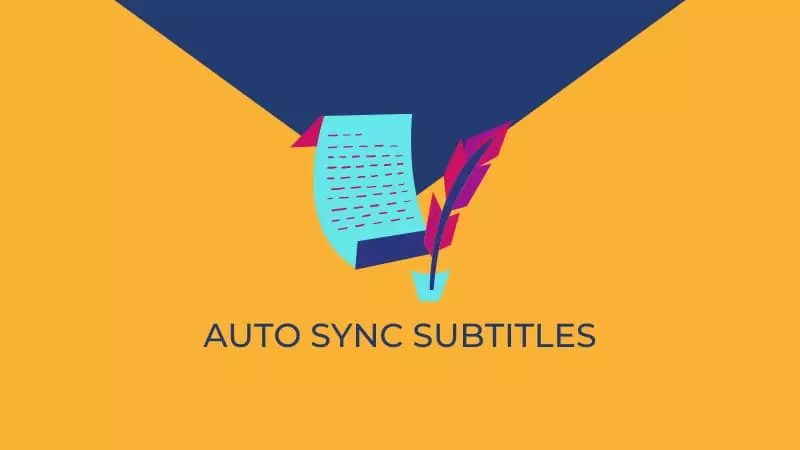
ಸ್ವಯಂಚಾಲಿತ ಉಪಶೀರ್ಷಿಕೆ ಸಿಂಕ್ರೊನೈಸೇಶನ್ನ ಪ್ರಮುಖ ತಾಂತ್ರಿಕ ತತ್ವಗಳು
ವೀಡಿಯೊ ನಿರ್ಮಾಣ, ಆನ್ಲೈನ್ ಶಿಕ್ಷಣ ಮತ್ತು ಕಾರ್ಪೊರೇಟ್ ತರಬೇತಿಯಲ್ಲಿ, ಪ್ರೇಕ್ಷಕರ ಅನುಭವ ಮತ್ತು ಮಾಹಿತಿ ವಿತರಣೆಗೆ ನಿಖರವಾದ ಉಪಶೀರ್ಷಿಕೆ ಸಿಂಕ್ರೊನೈಸೇಶನ್ ನಿರ್ಣಾಯಕವಾಗಿದೆ. ಅನೇಕ ಬಳಕೆದಾರರು ಕೇಳುತ್ತಾರೆ: "ಉಪಶೀರ್ಷಿಕೆಗಳನ್ನು ಸ್ವಯಂಚಾಲಿತವಾಗಿ ಸಿಂಕ್ ಮಾಡುವುದು ಹೇಗೆ?" ಸ್ವಯಂಚಾಲಿತ ಉಪಶೀರ್ಷಿಕೆ ಸಿಂಕ್ರೊನೈಸೇಶನ್ AI ಭಾಷಣ ಗುರುತಿಸುವಿಕೆ ಮತ್ತು ಟೈಮ್ಲೈನ್ ಹೊಂದಾಣಿಕೆಯ ತಂತ್ರಜ್ಞಾನವನ್ನು ಅವಲಂಬಿಸಿದೆ, ಇದು ಉಪಶೀರ್ಷಿಕೆಗಳು ಮತ್ತು ಆಡಿಯೊ ನಡುವೆ ನಿಖರವಾದ ಜೋಡಣೆಯನ್ನು ಖಚಿತಪಡಿಸಿಕೊಳ್ಳಲು, ವಿಳಂಬಗಳು ಅಥವಾ ಅಕಾಲಿಕ ಪ್ರದರ್ಶನಗಳನ್ನು ತೆಗೆದುಹಾಕುತ್ತದೆ.
ಈ ಲೇಖನವು ಸ್ವಯಂಚಾಲಿತ ಉಪಶೀರ್ಷಿಕೆ ಸಿಂಕ್ರೊನೈಸೇಶನ್ನ ಸಾಮಾನ್ಯ ವಿಧಾನಗಳು, ತಾಂತ್ರಿಕ ತತ್ವಗಳು ಮತ್ತು ತುಲನಾತ್ಮಕ ವಿಶ್ಲೇಷಣೆಗಳನ್ನು ವ್ಯವಸ್ಥಿತವಾಗಿ ಪರಿಚಯಿಸುತ್ತದೆ. Easysub ನ ಪ್ರಾಯೋಗಿಕ ಅನುಭವವನ್ನು ಆಧರಿಸಿ, ಇದು ಸೃಷ್ಟಿಕರ್ತರು ಮತ್ತು ಉದ್ಯಮಗಳಿಗೆ ದಕ್ಷ, ವೃತ್ತಿಪರ ಪರಿಹಾರಗಳನ್ನು ಒದಗಿಸುತ್ತದೆ.
DeepL.com ನಿಂದ ಅನುವಾದಿಸಲಾಗಿದೆ (ಉಚಿತ ಆವೃತ್ತಿ)
"ಉಪಶೀರ್ಷಿಕೆಗಳನ್ನು ಸ್ವಯಂಚಾಲಿತವಾಗಿ ಸಿಂಕ್ ಮಾಡುವುದು ಹೇಗೆ?" ಎಂದು ಚರ್ಚಿಸುವ ಮೊದಲು, ಉಪಶೀರ್ಷಿಕೆ ಸಿಂಕ್ರೊನೈಸೇಶನ್ನ ಮಹತ್ವವನ್ನು ನಾವು ಅರ್ಥಮಾಡಿಕೊಳ್ಳಬೇಕು. ಉಪಶೀರ್ಷಿಕೆಗಳು ಕೇವಲ ಪಠ್ಯ ಮತ್ತು ಆಡಿಯೊ ನಡುವಿನ ಸರಳ ಪತ್ರವ್ಯವಹಾರವಲ್ಲ; ಅವು ವೀಕ್ಷಕರ ಅನುಭವ, ಕಲಿಕೆಯ ಪರಿಣಾಮಕಾರಿತ್ವ ಮತ್ತು ವಿಷಯ ಪ್ರಸರಣದ ಮೇಲೆ ನೇರವಾಗಿ ಪರಿಣಾಮ ಬೀರುತ್ತವೆ.
ವಿಷಯ ನಿಖರವಾಗಿದ್ದರೂ ಸಹ, ಆಡಿಯೊದ ಮುಂದೆ ಅಥವಾ ಹಿಂದೆ ಉಪಶೀರ್ಷಿಕೆಗಳು ಕಾಣಿಸಿಕೊಂಡರೆ, ಅದು ವೀಕ್ಷಕರ ಅಸ್ವಸ್ಥತೆಯನ್ನು ಉಂಟುಮಾಡಬಹುದು ಮತ್ತು ಗಮನವನ್ನು ಕಡಿಮೆ ಮಾಡಬಹುದು. ನಿಖರವಾದ ಸಿಂಕ್ರೊನೈಸೇಶನ್ ವೀಕ್ಷಕರ ಶ್ರವಣೇಂದ್ರಿಯ ಮತ್ತು ದೃಶ್ಯ ಸೂಚನೆಗಳನ್ನು ಜೋಡಿಸುತ್ತದೆ, ಇದು ವಿಷಯದ ಹೆಚ್ಚು ನೈಸರ್ಗಿಕ ಗ್ರಹಿಕೆಯನ್ನು ಸಕ್ರಿಯಗೊಳಿಸುತ್ತದೆ.
ಶ್ರವಣದೋಷವುಳ್ಳವರಿಗೆ ಅಥವಾ ಬೇರೆ ಭಾಷೆ ಮಾತನಾಡುವವರಿಗೆ, ಉಪಶೀರ್ಷಿಕೆಗಳು ಮಾಹಿತಿಯ ಪ್ರಾಥಮಿಕ ಮೂಲವಾಗಿ ಕಾರ್ಯನಿರ್ವಹಿಸುತ್ತವೆ. ತಪ್ಪು ಜೋಡಣೆಯು ಅರ್ಥವನ್ನು ನಿಖರವಾಗಿ ಗ್ರಹಿಸುವುದನ್ನು ತಡೆಯಬಹುದು ಅಥವಾ ಸಂಪೂರ್ಣ ತಪ್ಪು ವ್ಯಾಖ್ಯಾನಕ್ಕೆ ಕಾರಣವಾಗಬಹುದು.
ಶೈಕ್ಷಣಿಕ, ತರಬೇತಿ ಅಥವಾ ಕಾರ್ಪೊರೇಟ್ ಪ್ರಚಾರದ ವೀಡಿಯೊಗಳಲ್ಲಿ, ಸಿಂಕ್ ಆಗದ ಉಪಶೀರ್ಷಿಕೆಗಳು ವೃತ್ತಿಪರವಲ್ಲದಂತೆ ಕಾಣುತ್ತವೆ ಮತ್ತು ಬ್ರ್ಯಾಂಡ್ ವಿಶ್ವಾಸಾರ್ಹತೆಯನ್ನು ಹಾಳುಮಾಡುತ್ತವೆ. ಸಿಂಕ್ರೊನೈಸ್ ಮಾಡಿದ ಉಪಶೀರ್ಷಿಕೆಗಳು ಮಾಹಿತಿಯ ಅಧಿಕಾರವನ್ನು ಹೆಚ್ಚಿಸುತ್ತವೆ ಮತ್ತು ಸಂವಹನ ಪರಿಣಾಮಕಾರಿತ್ವವನ್ನು ಬಲಪಡಿಸುತ್ತವೆ.
ಸರಿಯಾಗಿ ಸಿಂಕ್ರೊನೈಸ್ ಮಾಡಲಾದ ಉಪಶೀರ್ಷಿಕೆ ಫೈಲ್ಗಳು (ಉದಾ, SRT, VTT) ವೀಕ್ಷಕರಿಗೆ ಪ್ರಯೋಜನವನ್ನು ನೀಡುವುದಲ್ಲದೆ, ಹುಡುಕಾಟ ಎಂಜಿನ್ಗಳಿಂದ ಸೂಚ್ಯಂಕವನ್ನು ಪಡೆಯುತ್ತವೆ, Google ಮತ್ತು YouTube ನಲ್ಲಿ ವೀಡಿಯೊ ಶ್ರೇಯಾಂಕಗಳನ್ನು ಸುಧಾರಿಸುತ್ತವೆ.
"ಉಪಶೀರ್ಷಿಕೆಗಳನ್ನು ಸ್ವಯಂಚಾಲಿತವಾಗಿ ಸಿಂಕ್ ಮಾಡುವುದು ಹೇಗೆ?" ಎಂಬುದನ್ನು ಅನ್ವೇಷಿಸುವ ಮೊದಲು, ಹಸ್ತಚಾಲಿತ ಅಥವಾ ಸಾಂಪ್ರದಾಯಿಕ ವಿಧಾನಗಳಲ್ಲಿನ ಸಾಮಾನ್ಯ ಸಿಂಕ್ರೊನೈಸೇಶನ್ ಸಮಸ್ಯೆಗಳನ್ನು ಮೊದಲು ಅರ್ಥಮಾಡಿಕೊಳ್ಳಿ:
ಸ್ವಯಂಚಾಲಿತ ಉಪಶೀರ್ಷಿಕೆ ಸಿಂಕ್ರೊನೈಸೇಶನ್ನಲ್ಲಿ ಮೊದಲ ಹಂತವೆಂದರೆ ಆಡಿಯೋವನ್ನು ಟೈಮ್ಸ್ಟ್ಯಾಂಪ್ಗಳೊಂದಿಗೆ ಪಠ್ಯವಾಗಿ ಪರಿವರ್ತಿಸುವುದು. ಪ್ರಾಥಮಿಕ ಕಾರ್ಯಪ್ರವಾಹ:
ವೈಶಿಷ್ಟ್ಯ ಹೊರತೆಗೆಯುವಿಕೆ (ಮುಂಭಾಗ): ನಿರಂತರ ಆಡಿಯೊವನ್ನು ಸಣ್ಣ ಫ್ರೇಮ್ಗಳಾಗಿ ವಿಂಗಡಿಸಿ (ಸಾಮಾನ್ಯವಾಗಿ 20–25 ms) ಮತ್ತು ಪ್ರತಿ ಫ್ರೇಮ್ಗೆ ಅಕೌಸ್ಟಿಕ್ ವೈಶಿಷ್ಟ್ಯಗಳನ್ನು ಲೆಕ್ಕಾಚಾರ ಮಾಡಿ (ಉದಾ, MFCC, ಲಾಗ್-ಮೆಲ್ ಫಿಲ್ಟರ್ಬ್ಯಾಂಕ್ಗಳು).
ಉದಾಹರಣೆ ನಿಯತಾಂಕಗಳು: ಮಾದರಿ ದರ 16,000 Hz, ವಿಂಡೋ ಗಾತ್ರ 25 ms, ಸ್ಟ್ರೈಡ್ 10 ms.
ಲೆಕ್ಕಾಚಾರದ ಉದಾಹರಣೆ (ಪ್ರತಿ ಫ್ರೇಮ್ಗೆ):
ಅಕೌಸ್ಟಿಕ್ ಮಾಡೆಲಿಂಗ್: ನರಮಂಡಲವು ಪ್ರತಿ ಫ್ರೇಮ್ ಅನ್ನು ಫೋನೆಮ್ ಅಥವಾ ಅಕ್ಷರ ಸಂಭವನೀಯತೆಗಳಿಗೆ ನಕ್ಷೆ ಮಾಡುತ್ತದೆ (ಸಾಂಪ್ರದಾಯಿಕ ವಿಧಾನಗಳು GMM-HMM ಅನ್ನು ಬಳಸುತ್ತವೆ; ಆಧುನಿಕ ವಿಧಾನಗಳು ಆಳವಾದ ಮಾದರಿಗಳು ಅಥವಾ CTC / RNN-T / ಟ್ರಾನ್ಸ್ಫಾರ್ಮರ್-ಆಧಾರಿತದಂತಹ ಅಂತ್ಯದಿಂದ ಅಂತ್ಯದ ಮಾದರಿಗಳನ್ನು ಬೆಂಬಲಿಸುತ್ತವೆ).
ಡಿಕೋಡಿಂಗ್ ಮತ್ತು ಭಾಷಾ ಮಾದರಿ ಸಮ್ಮಿಳನ: ಫ್ರೇಮ್-ಮಟ್ಟದ ಸಂಭವನೀಯತೆಗಳನ್ನು ಪಠ್ಯ ಅನುಕ್ರಮಗಳಾಗಿ ಪರಿವರ್ತಿಸಲು ಭಾಷಾ ಮಾದರಿಯನ್ನು (n-gram ಅಥವಾ ನರ LM) ಡಿಕೋಡರ್ (ಬೀಮ್ ಹುಡುಕಾಟ) ನೊಂದಿಗೆ ಸಂಯೋಜಿಸುತ್ತದೆ, ಪ್ರತಿ ಪದ/ಉಪಪದಕ್ಕೆ ಸಮಯದ ಶ್ರೇಣಿಯನ್ನು (ಆರಂಭದ ಫ್ರೇಮ್, ಅಂತ್ಯ ಫ್ರೇಮ್) ಔಟ್ಪುಟ್ ಮಾಡುತ್ತದೆ.
ಟೈಮ್ಕೋಡ್ಗೆ ಮ್ಯಾಪಿಂಗ್: ಫ್ರೇಮ್ ಸೂಚ್ಯಂಕಗಳನ್ನು ಹಾಪ್ ಅವಧಿಗಳಿಂದ ಗುಣಿಸಿ ಸೆಕೆಂಡುಗಳನ್ನು ನೀಡಲಾಗುತ್ತದೆ, ಇದು ಪ್ರಾಥಮಿಕ ಪದ-ಮಟ್ಟ ಅಥವಾ ವಿಭಾಗ-ಮಟ್ಟದ ಸಮಯಸ್ಟ್ಯಾಂಪ್ಗಳನ್ನು ಉತ್ಪಾದಿಸುತ್ತದೆ.
ನೀವು ಮೊದಲೇ ಅಸ್ತಿತ್ವದಲ್ಲಿರುವ ಪ್ರತಿಲೇಖನವನ್ನು ಹೊಂದಿದ್ದರೂ ಅದನ್ನು ಆಡಿಯೊದೊಂದಿಗೆ ನಿಖರವಾಗಿ ಜೋಡಿಸಬೇಕಾದರೆ, ಸಾಮಾನ್ಯ ವಿಧಾನವನ್ನು ಬಲವಂತದ ಜೋಡಣೆ ಎಂದು ಕರೆಯಲಾಗುತ್ತದೆ:
ದೀರ್ಘ ಆಡಿಯೊ ಕ್ಲಿಪ್ಗಳನ್ನು ಸಮಂಜಸವಾದ ಭಾಗಗಳಾಗಿ ವಿಭಜಿಸುವುದರಿಂದ ಜೋಡಣೆ ಸ್ಥಿರತೆ ಮತ್ತು ಸಂಸ್ಕರಣಾ ವೇಗ ಗಮನಾರ್ಹವಾಗಿ ಸುಧಾರಿಸುತ್ತದೆ:
ವಿವಿಧ ಸನ್ನಿವೇಶಗಳಲ್ಲಿ ಸಮಯಸ್ಟ್ಯಾಂಪ್ಗಳನ್ನು ಸೂಕ್ಷ್ಮವಾಗಿ ಶ್ರುತಿಗೊಳಿಸಲು ವಿಭಿನ್ನ ಅಲ್ಗಾರಿದಮ್ಗಳನ್ನು ಬಳಸಲಾಗುತ್ತದೆ:
ಗಮನ-ಆಧಾರಿತ ಜೋಡಣೆ: Seq2Seq ಮಾದರಿಗಳಲ್ಲಿ ಗಮನ ತೂಕವನ್ನು ಬಳಸಿಕೊಂಡು ಮೃದು ಜೋಡಣೆ (ಗಮನಿಸಿ: ಗಮನವು ಕಟ್ಟುನಿಟ್ಟಾದ ಸಮಯ ಜೋಡಣೆಯಲ್ಲ ಮತ್ತು ನಂತರದ ಪ್ರಕ್ರಿಯೆಯ ಅಗತ್ಯವಿದೆ).
ಸಾಮಾನ್ಯ ಉಪಶೀರ್ಷಿಕೆ ಸಿಂಕ್ರೊನೈಸೇಶನ್ ಸಮಸ್ಯೆಗಳು ಎರಡು ವರ್ಗಗಳಾಗಿ ಬರುತ್ತವೆ: ಒಟ್ಟಾರೆ ಆಫ್ಸೆಟ್ (ಎಲ್ಲಾ ಟೈಮ್ಸ್ಟ್ಯಾಂಪ್ಗಳು ಸ್ಥಿರವಾಗಿ ಮುಂದೆ ಅಥವಾ ಹಿಂದೆ) ಮತ್ತು ಕಾಲಾನಂತರದಲ್ಲಿ ಸಂಚಿತ ಡ್ರಿಫ್ಟ್ (ಪ್ಲೇಬ್ಯಾಕ್ ಮುಂದುವರೆದಂತೆ ಹೆಚ್ಚುತ್ತಿರುವ ವಿಚಲನ).
ಪ್ರತಿಯೊಂದು ವಿಧಾನವು ಅದರ ಸಾಧಕ-ಬಾಧಕಗಳನ್ನು ಹೊಂದಿದೆ. ಪ್ಲಾಟ್ಫಾರ್ಮ್-ನಿರ್ಮಿತ ಪರಿಕರಗಳು ಸಾಮಾನ್ಯ ರಚನೆಕಾರರಿಗೆ ಸರಿಹೊಂದುತ್ತವೆ, ಓಪನ್-ಸೋರ್ಸ್ ಸಾಫ್ಟ್ವೇರ್ ತಂತ್ರಜ್ಞಾನ-ಬುದ್ಧಿವಂತ ಬಳಕೆದಾರರನ್ನು ಪೂರೈಸುತ್ತದೆ, ಆದರೆ ಹೆಚ್ಚಿನ ನಿಖರತೆ ಮತ್ತು ದಕ್ಷತೆಯ ಅಗತ್ಯವಿರುವವರು ಹೆಚ್ಚು ವಿಶ್ವಾಸಾರ್ಹ ಸ್ವಯಂಚಾಲಿತ ಉಪಶೀರ್ಷಿಕೆ ಸಿಂಕ್ರೊನೈಸೇಶನ್ ಅನುಭವಕ್ಕಾಗಿ Easysub ನಂತಹ ವೃತ್ತಿಪರ AI ಪರಿಕರಗಳನ್ನು ಆರಿಸಿಕೊಳ್ಳಬೇಕು.
| ವಿಧಾನ | ನಿಖರತೆ | ಬಳಕೆಯ ಸುಲಭತೆ | ವೇಗ | ಅತ್ಯುತ್ತಮ ಬಳಕೆಯ ಸಂದರ್ಭಗಳು | ಮಿತಿಗಳು |
|---|---|---|---|---|---|
| YouTube ಸ್ಟುಡಿಯೋ | ಮಧ್ಯಮ (70%–85%) | ಸುಲಭ | ವೇಗ (ಅಪ್ಲೋಡ್ ಮಾತ್ರ) | ವೀಡಿಯೊ ರಚನೆಕಾರರು, YouTube ಪ್ರಕಾಶಕರು | ಆಡಿಯೊ ಗುಣಮಟ್ಟವನ್ನು ಅವಲಂಬಿಸಿದೆ, ಸಂಕೀರ್ಣ ಪ್ರಕರಣಗಳಿಗೆ ಸೀಮಿತವಾಗಿದೆ. |
| ಉಚಿತ ಸಾಫ್ಟ್ವೇರ್ (ಉಪಶೀರ್ಷಿಕೆ ಸಂಪಾದನೆ / ಏಜಿಸಬ್) | ಮಧ್ಯಮದಿಂದ ಅಧಿಕ (75%–90%) | ಮಧ್ಯಮ (ಕಲಿಕೆಯ ರೇಖೆ) | ಸಾಕಷ್ಟು ವೇಗವಾಗಿ (ಹಸ್ತಚಾಲಿತ ಆಮದು) | ತಂತ್ರಜ್ಞಾನ-ಬುದ್ಧಿವಂತ ಬಳಕೆದಾರರು, ಕಸ್ಟಮ್ ಉಪಶೀರ್ಷಿಕೆ ಕಾರ್ಯಪ್ರವಾಹಗಳು | ಕಡಿದಾದ ಕಲಿಕೆಯ ರೇಖೆ, ಆರಂಭಿಕರಿಗಾಗಿ ಅಲ್ಲ |
| ಈಸಿಸಬ್ (AI ಟೂಲ್) | ಅಧಿಕ (90%–98%) | ತುಂಬಾ ಸುಲಭ | ವೇಗ (ಸಂಪೂರ್ಣ ಸ್ವಯಂಚಾಲಿತ) | ಶಿಕ್ಷಣ, ವ್ಯವಹಾರಗಳು, ವೃತ್ತಿಪರ ರಚನೆಕಾರರು, ಬಹುಭಾಷಾ | ಕೆಲವು ಸುಧಾರಿತ ವೈಶಿಷ್ಟ್ಯಗಳಿಗೆ ಚಂದಾದಾರಿಕೆ ಅಗತ್ಯವಿರುತ್ತದೆ. |
AI ಮತ್ತು ದೊಡ್ಡ ಭಾಷಾ ಮಾದರಿಗಳ (LLMs) ಪ್ರಗತಿಯೊಂದಿಗೆ, “ಉಪಶೀರ್ಷಿಕೆಗಳನ್ನು ಸ್ವಯಂಚಾಲಿತವಾಗಿ ಸಿಂಕ್ ಮಾಡುವುದು ಹೇಗೆ?” ಎಂಬ ಪ್ರಶ್ನೆಗೆ ಉತ್ತರವು ಚುರುಕಾಗಿರುತ್ತದೆ ಮತ್ತು ಹೆಚ್ಚು ಪರಿಣಾಮಕಾರಿಯಾಗಿರುತ್ತದೆ. ಭವಿಷ್ಯದಲ್ಲಿ, ಸ್ವಯಂಚಾಲಿತ ಉಪಶೀರ್ಷಿಕೆ ಸಿಂಕ್ರೊನೈಸೇಶನ್ ಮಾನವ ಮಟ್ಟದ ನಿಖರತೆಯನ್ನು ಸಮೀಪಿಸುವುದಲ್ಲದೆ, ನೈಜ-ಸಮಯದ ಬಹುಭಾಷಾ ಅನುವಾದ, ಸ್ವಯಂಚಾಲಿತ ಸ್ಪೀಕರ್ ಗುರುತಿಸುವಿಕೆ ಮತ್ತು ವೈಯಕ್ತಿಕಗೊಳಿಸಿದ ಉಪಶೀರ್ಷಿಕೆ ಶೈಲಿಗಳನ್ನು ಸಹ ಬೆಂಬಲಿಸುತ್ತದೆ. ಈ ಸಾಮರ್ಥ್ಯಗಳು ಲೈವ್ ಸ್ಟ್ರೀಮಿಂಗ್, ಆನ್ಲೈನ್ ಶಿಕ್ಷಣ ಮತ್ತು ಜಾಗತಿಕ ಕಾರ್ಪೊರೇಟ್ ಸಂವಹನಗಳಲ್ಲಿ ವ್ಯಾಪಕವಾದ ಅನ್ವಯಿಕೆಯನ್ನು ಕಂಡುಕೊಳ್ಳುತ್ತವೆ. Easysub ನಂತಹ ವೃತ್ತಿಪರ ಪರಿಕರಗಳು ಬಳಕೆದಾರರ ಅಗತ್ಯತೆಗಳೊಂದಿಗೆ AI ತಂತ್ರಜ್ಞಾನವನ್ನು ಸಂಯೋಜಿಸುವುದನ್ನು ಮುಂದುವರಿಸುತ್ತವೆ, ರಚನೆಕಾರರು ಮತ್ತು ವ್ಯವಹಾರಗಳಿಗೆ ಹೆಚ್ಚು ಹೊಂದಿಕೊಳ್ಳುವ ಮತ್ತು ನಿಖರವಾದ ಸಿಂಕ್ರೊನೈಸೇಶನ್ ಪರಿಹಾರಗಳನ್ನು ಒದಗಿಸುತ್ತವೆ.
ಸಂಕ್ಷಿಪ್ತವಾಗಿ ಹೇಳುವುದಾದರೆ, “ಉಪಶೀರ್ಷಿಕೆಗಳನ್ನು ಸ್ವಯಂಚಾಲಿತವಾಗಿ ಸಿಂಕ್ ಮಾಡುವುದು ಹೇಗೆ?” ಎಂಬ ಪ್ರಶ್ನೆಗೆ ಉತ್ತರ ಸರಳವಾಗಿದೆ: ಬಳಕೆದಾರರು YouTube ಸ್ಟುಡಿಯೋ, ಓಪನ್-ಸೋರ್ಸ್ ಸಾಫ್ಟ್ವೇರ್ ಅಥವಾ ವೃತ್ತಿಪರ AI ಪರಿಕರಗಳ ಮೂಲಕ ಉಪಶೀರ್ಷಿಕೆಗಳು ಮತ್ತು ಆಡಿಯೊ ನಡುವೆ ಸ್ವಯಂಚಾಲಿತ ಸಿಂಕ್ರೊನೈಸೇಶನ್ ಅನ್ನು ಸಾಧಿಸಬಹುದು. ಆದಾಗ್ಯೂ, ಈ ವಿಧಾನಗಳು ನಿಖರತೆ, ದಕ್ಷತೆ ಮತ್ತು ಬಳಕೆಯ ಸುಲಭತೆಯಲ್ಲಿ ಗಮನಾರ್ಹವಾಗಿ ಭಿನ್ನವಾಗಿವೆ.
ಸಾಮಾನ್ಯ ರಚನೆಕಾರರಿಗೆ, ಮೂಲಭೂತ ಅಗತ್ಯಗಳಿಗೆ ಪ್ಲಾಟ್ಫಾರ್ಮ್-ಸ್ಥಳೀಯ ವೈಶಿಷ್ಟ್ಯಗಳು ಸಾಕು. ಶಿಕ್ಷಣ, ಉದ್ಯಮ ಮತ್ತು ವೃತ್ತಿಪರ ವಿಷಯ ರಚನೆಯಲ್ಲಿ, Easysub ನಂತಹ AI-ಚಾಲಿತ ಪರಿಕರಗಳು ಹೆಚ್ಚಿನ ನಿಖರತೆಯನ್ನು ಖಚಿತಪಡಿಸಿಕೊಳ್ಳುವಾಗ ಹಸ್ತಚಾಲಿತ ಹೊಂದಾಣಿಕೆ ಸಮಯವನ್ನು ಗಮನಾರ್ಹವಾಗಿ ಕಡಿಮೆ ಮಾಡುತ್ತದೆ. ಉಪಶೀರ್ಷಿಕೆ ಸಿಂಕ್ರೊನೈಸೇಶನ್ ಬಳಕೆದಾರರ ಅನುಭವ ಮತ್ತು ಪ್ರವೇಶವನ್ನು ಹೆಚ್ಚಿಸುವುದಲ್ಲದೆ, ವಿಷಯ ವೃತ್ತಿಪರತೆ ಮತ್ತು ಜಾಗತಿಕ ವ್ಯಾಪ್ತಿಯನ್ನು ಹೆಚ್ಚಿಸುವಲ್ಲಿ ನಿರ್ಣಾಯಕ ಹೆಜ್ಜೆಯಾಗಿಯೂ ಕಾರ್ಯನಿರ್ವಹಿಸುತ್ತದೆ.
ವಿಷಯ ಜಾಗತೀಕರಣ ಮತ್ತು ಕಿರು-ರೂಪದ ವೀಡಿಯೊ ಸ್ಫೋಟದ ಯುಗದಲ್ಲಿ, ವೀಡಿಯೊಗಳ ಗೋಚರತೆ, ಪ್ರವೇಶಸಾಧ್ಯತೆ ಮತ್ತು ವೃತ್ತಿಪರತೆಯನ್ನು ಹೆಚ್ಚಿಸಲು ಸ್ವಯಂಚಾಲಿತ ಉಪಶೀರ್ಷಿಕೆಯು ಪ್ರಮುಖ ಸಾಧನವಾಗಿದೆ.
AI ಉಪಶೀರ್ಷಿಕೆ ಜನರೇಷನ್ ಪ್ಲಾಟ್ಫಾರ್ಮ್ಗಳೊಂದಿಗೆ ಈಸಿಸಬ್, ವಿಷಯ ರಚನೆಕಾರರು ಮತ್ತು ವ್ಯವಹಾರಗಳು ಕಡಿಮೆ ಸಮಯದಲ್ಲಿ ಉತ್ತಮ ಗುಣಮಟ್ಟದ, ಬಹುಭಾಷಾ, ನಿಖರವಾಗಿ ಸಿಂಕ್ರೊನೈಸ್ ಮಾಡಿದ ವೀಡಿಯೊ ಉಪಶೀರ್ಷಿಕೆಗಳನ್ನು ಉತ್ಪಾದಿಸಬಹುದು, ವೀಕ್ಷಣೆಯ ಅನುಭವ ಮತ್ತು ವಿತರಣಾ ದಕ್ಷತೆಯನ್ನು ನಾಟಕೀಯವಾಗಿ ಸುಧಾರಿಸಬಹುದು.
ವಿಷಯ ಜಾಗತೀಕರಣ ಮತ್ತು ಕಿರು-ರೂಪದ ವೀಡಿಯೊ ಸ್ಫೋಟದ ಯುಗದಲ್ಲಿ, ವೀಡಿಯೊಗಳ ಗೋಚರತೆ, ಪ್ರವೇಶಸಾಧ್ಯತೆ ಮತ್ತು ವೃತ್ತಿಪರತೆಯನ್ನು ಹೆಚ್ಚಿಸಲು ಸ್ವಯಂಚಾಲಿತ ಉಪಶೀರ್ಷಿಕೆ ಒಂದು ಪ್ರಮುಖ ಸಾಧನವಾಗಿದೆ. Easysub ನಂತಹ AI ಉಪಶೀರ್ಷಿಕೆ ಉತ್ಪಾದನಾ ವೇದಿಕೆಗಳೊಂದಿಗೆ, ವಿಷಯ ರಚನೆಕಾರರು ಮತ್ತು ವ್ಯವಹಾರಗಳು ಕಡಿಮೆ ಸಮಯದಲ್ಲಿ ಉತ್ತಮ-ಗುಣಮಟ್ಟದ, ಬಹುಭಾಷಾ, ನಿಖರವಾಗಿ ಸಿಂಕ್ರೊನೈಸ್ ಮಾಡಿದ ವೀಡಿಯೊ ಉಪಶೀರ್ಷಿಕೆಗಳನ್ನು ಉತ್ಪಾದಿಸಬಹುದು, ವೀಕ್ಷಣೆಯ ಅನುಭವ ಮತ್ತು ವಿತರಣಾ ದಕ್ಷತೆಯನ್ನು ನಾಟಕೀಯವಾಗಿ ಸುಧಾರಿಸಬಹುದು.
ನೀವು ಹರಿಕಾರರಾಗಿರಲಿ ಅಥವಾ ಅನುಭವಿ ಸೃಷ್ಟಿಕರ್ತರಾಗಿರಲಿ, Easysub ನಿಮ್ಮ ವಿಷಯವನ್ನು ವೇಗಗೊಳಿಸಬಹುದು ಮತ್ತು ಸಬಲೀಕರಣಗೊಳಿಸಬಹುದು. ಈಗಲೇ Easysub ಅನ್ನು ಉಚಿತವಾಗಿ ಪ್ರಯತ್ನಿಸಿ ಮತ್ತು AI ಉಪಶೀರ್ಷಿಕೆಗಳ ದಕ್ಷತೆ ಮತ್ತು ಬುದ್ಧಿವಂತಿಕೆಯನ್ನು ಅನುಭವಿಸಿ, ಪ್ರತಿ ವೀಡಿಯೊವು ಭಾಷಾ ಗಡಿಗಳನ್ನು ಮೀರಿ ಜಾಗತಿಕ ಪ್ರೇಕ್ಷಕರನ್ನು ತಲುಪಲು ಅನುವು ಮಾಡಿಕೊಡುತ್ತದೆ!
ಕೆಲವೇ ನಿಮಿಷಗಳಲ್ಲಿ AI ನಿಮ್ಮ ವಿಷಯವನ್ನು ಸಬಲೀಕರಣಗೊಳಿಸಲಿ!
👉 ಉಚಿತ ಪ್ರಯೋಗಕ್ಕಾಗಿ ಇಲ್ಲಿ ಕ್ಲಿಕ್ ಮಾಡಿ: ಈಸಿಸಬ್.ಕಾಮ್
ಈ ಬ್ಲಾಗ್ ಓದಿದ್ದಕ್ಕಾಗಿ ಧನ್ಯವಾದಗಳು. ಹೆಚ್ಚಿನ ಪ್ರಶ್ನೆಗಳು ಅಥವಾ ಗ್ರಾಹಕೀಕರಣ ಅಗತ್ಯಗಳಿಗಾಗಿ ನಮ್ಮನ್ನು ಸಂಪರ್ಕಿಸಲು ಮುಕ್ತವಾಗಿರಿ!
ನೀವು ಸಾಮಾಜಿಕ ಮಾಧ್ಯಮದಲ್ಲಿ ವೀಡಿಯೊವನ್ನು ಹಂಚಿಕೊಳ್ಳಬೇಕೇ? ನಿಮ್ಮ ವೀಡಿಯೊ ಉಪಶೀರ್ಷಿಕೆಗಳನ್ನು ಹೊಂದಿದೆಯೇ?...
5 ಅತ್ಯುತ್ತಮ ಸ್ವಯಂಚಾಲಿತ ಉಪಶೀರ್ಷಿಕೆ ಜನರೇಟರ್ಗಳು ಯಾವುವು ಎಂದು ತಿಳಿಯಲು ನೀವು ಬಯಸುವಿರಾ? ಬಂದು…
ಒಂದೇ ಕ್ಲಿಕ್ನಲ್ಲಿ ವೀಡಿಯೊಗಳನ್ನು ರಚಿಸಿ. ಉಪಶೀರ್ಷಿಕೆಗಳನ್ನು ಸೇರಿಸಿ, ಆಡಿಯೋ ಲಿಪ್ಯಂತರ ಮತ್ತು ಇನ್ನಷ್ಟು
ಸರಳವಾಗಿ ವೀಡಿಯೊಗಳನ್ನು ಅಪ್ಲೋಡ್ ಮಾಡಿ ಮತ್ತು ಸ್ವಯಂಚಾಲಿತವಾಗಿ ಅತ್ಯಂತ ನಿಖರವಾದ ಪ್ರತಿಲೇಖನ ಉಪಶೀರ್ಷಿಕೆಗಳನ್ನು ಪಡೆಯಿರಿ ಮತ್ತು 150+ ಉಚಿತ ಬೆಂಬಲವನ್ನು ಪಡೆಯಿರಿ...
Youtube, VIU, Viki, Vlive, ಇತ್ಯಾದಿಗಳಿಂದ ನೇರವಾಗಿ ಉಪಶೀರ್ಷಿಕೆಗಳನ್ನು ಡೌನ್ಲೋಡ್ ಮಾಡಲು ಉಚಿತ ವೆಬ್ ಅಪ್ಲಿಕೇಶನ್.
ಉಪಶೀರ್ಷಿಕೆಗಳನ್ನು ಹಸ್ತಚಾಲಿತವಾಗಿ ಸೇರಿಸಿ, ಸ್ವಯಂಚಾಲಿತವಾಗಿ ಲಿಪ್ಯಂತರ ಅಥವಾ ಉಪಶೀರ್ಷಿಕೆ ಫೈಲ್ಗಳನ್ನು ಅಪ್ಲೋಡ್ ಮಾಡಿ
